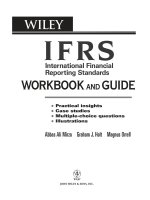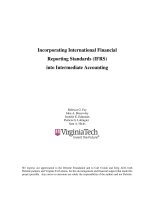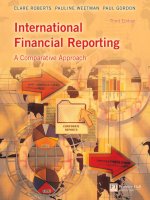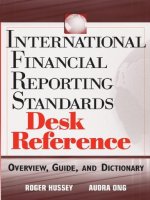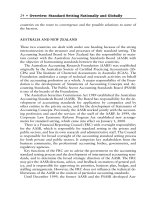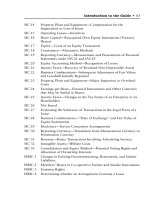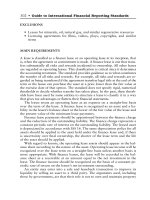IFRS international financial reporting standards part a (2010)
Bạn đang xem bản rút gọn của tài liệu. Xem và tải ngay bản đầy đủ của tài liệu tại đây (4.93 MB, 1,186 trang )
International Financial Reporting
Standards®
as issued at 1 January 2010
This edition published in two parts
PART A
International Financial Reporting
Standards®
as issued at 1 January 2010
This edition published in two parts
PART A
The consolidated text of International Financial Reporting Standards (IFRSs®)
including International Accounting Standards (IASs®) and Interpretations,
and the Preface to IFRSs as issued at 1 January 2010
For the accompanying documents published with IFRSs,
and other relevant material, see Part B of this edition
International Accounting Standards Board®
30 Cannon Street
London EC4M 6XH
United Kingdom
Telephone: +44 (0)20 7246 6410
Fax: +44 (0)20 7246 6411
Email:
Publications Telephone: +44 (0)20 7332 2730
Publications Fax: +44 (0)20 7332 2749
Publications Email:
Web: www.iasb.org
IFRSs together with their accompanying documents are issued by the
International Accounting Standards Board (IASB),
30 Cannon Street, London EC4M 6XH, United Kingdom.
Tel: +44 (0)20 7246 6410 Fax: +44 (0)20 7246 6411
Email: Web: www.iasb.org
ISBN for this part: 978-1-907026-61-4
ISBN for complete publication (two parts): 978-1-907026-60-7
Copyright © 2010 International Accounting Standards Committee Foundation
(IASCF).
International Financial Reporting Standards, International Accounting
Standards, Interpretations, Exposure Drafts, and other IASB publications are
copyright of the IASCF. The approved text of International Financial Reporting
Standards, including International Accounting Standards and Interpretations, is
that issued by the IASB in the English language. Copies may be obtained from the
IASCF Publications Department. Please address publication and copyright
matters to:
IASC Foundation Publications Department
30 Cannon Street, London EC4M 6XH, United Kingdom.
Telephone: +44 (0)20 7332 2730 Fax: +44 (0)20 7332 2749
Email: Web: www.iasb.org
All rights reserved. No part of this publication may be translated, reprinted or
reproduced or utilised in any form either in whole or in part or by any electronic,
mechanical or other means, now known or hereafter invented, including
photocopying and recording, or in any information storage and retrieval system,
without prior permission in writing from the IASCF.
The IASB, the IASCF, the authors and the publishers do not accept responsibility
for loss caused to any person who acts or refrains from acting in reliance on the
material in this publication, whether such loss is caused by negligence or
otherwise.
The IASB logo/the IASCF logo/‘Hexagon Device’, the IASC Foundation Education logo,
‘IASC Foundation’, ‘eIFRS’, ‘IAS’, ‘IASB’, ‘IASC’, ‘IASCF’, ‘IASs’, ‘IFRIC’, ‘IFRS’, ‘IFRSs’,
‘International Accounting Standards’, ‘International Financial Reporting Standards’ and
‘SIC’ are Trade Marks of the IASCF.
Contents
Changes in this edition
A1
Introduction to this edition
A5
Preface to International Financial Reporting Standards
A15
International Financial Reporting Standards (IFRSs)
IFRS 1
First-time Adoption of International Financial Reporting
Standards
A21
IFRS 2
Share-based Payment
A51
IFRS 3
Business Combinations
A93
IFRS 4
Insurance Contracts
A141
IFRS 5
Non-current Assets Held for Sale and Discontinued Operations
A171
IFRS 6
Exploration for and Evaluation of Mineral Resources
A191
IFRS 7
Financial Instruments: Disclosures
A203
IFRS 8
Operating Segments
A237
IFRS 9
Financial Instruments
A255
International Accounting Standards (IASs)
IAS 1
Presentation of Financial Statements
A283
IAS 2
Inventories
A321
IAS 7
Statement of Cash Flows
A337
IAS 8
Accounting Policies, Changes in Accounting Estimates and
Errors
A351
IAS 10
Events after the Reporting Period
A371
IAS 11
Construction Contracts
A383
IAS 12
Income Taxes
A395
IAS 16
Property, Plant and Equipment
A431
IAS 17
Leases
A455
IAS 18
Revenue
A475
IAS 19
Employee Benefits
A487
IAS 20
Accounting for Government Grants and Disclosure of
Government Assistance
A541
IAS 21
The Effects of Changes in Foreign Exchange Rates
A551
IAS 23
Borrowing Costs
A573
IAS 24
Related Party Disclosures
A583
IAS 26
Accounting and Reporting by Retirement Benefit Plans
A595
©
IASCF
v
IAS 27
Consolidated and Separate Financial Statements
A607
IAS 28
Investments in Associates
A625
IAS 29
Financial Reporting in Hyperinflationary Economies
A641
IAS 31
Interests in Joint Ventures
A651
IAS 32
Financial Instruments: Presentation
A669
IAS 33
Earnings per Share
A711
IAS 34
Interim Financial Reporting
A737
IAS 36
Impairment of Assets
A753
IAS 37
Provisions, Contingent Liabilities and Contingent Assets
A803
IAS 38
Intangible Assets
A827
IAS 39
Financial Instruments: Recognition and Measurement
A863
IAS 40
Investment Property
A949
IAS 41
Agriculture
A973
Interpretations
IFRIC 1
Changes in Existing Decommissioning, Restoration and Similar
Liabilities
A989
IFRIC 2
Members’ Shares in Co-operative Entities and Similar
Instruments
A997
IFRIC 4
Determining whether an Arrangement contains a Lease
A1009
IFRIC 5
Rights to Interests arising from Decommissioning, Restoration
and Environmental Rehabilitation Funds
A1019
IFRIC 6
Liabilities arising from Participating in a Specific Market—
Waste Electrical and Electronic Equipment
A1027
IFRIC 7
Applying the Restatement Approach under IAS 29 Financial
Reporting in Hyperinflationary Economies
A1033
IFRIC 9
Reassessment of Embedded Derivatives
A1039
IFRIC 10 Interim Financial Reporting and Impairment
A1045
IFRIC 12 Service Concession Arrangements
A1051
IFRIC 13 Customer Loyalty Programmes
A1063
IFRIC 14 IAS 19—The Limit on a Defined Benefit Asset, Minimum
Funding Requirements and their Interaction
A1071
IFRIC 15 Agreements for the Construction of Real Estate
A1081
IFRIC 16 Hedges of a Net Investment in a Foreign Operation
A1089
IFRIC 17 Distributions of Non-cash Assets to Owners
A1103
IFRIC 18 Transfers of Assets from Customers
A1111
IFRIC 19 Extinguishing Financial Liabilities with Equity Instruments
A1119
vi
©
IASCF
SIC-7
Introduction of the Euro
A1127
SIC-10
Government Assistance—No Specific Relation to Operating
Activities
A1131
SIC-12
Consolidation—Special Purpose Entities
A1135
SIC-13
Jointly Controlled Entities—Non-Monetary Contributions by
Venturers
A1141
SIC-15
Operating Leases—Incentives
A1145
SIC-21
Income Taxes—Recovery of Revalued Non-Depreciable Assets
A1149
SIC-25
Income Taxes—Changes in the Tax Status of an Entity or its
Shareholders
A1153
SIC-27
Evaluating the Substance of Transactions Involving the Legal
Form of a Lease
A1157
SIC-29
Service Concession Arrangements: Disclosures
A1163
SIC-31
Revenue—Barter Transactions Involving Advertising Services
A1169
SIC-32
Intangible Assets—Web Site Costs
A1173
©
IASCF
vii
Changes in this edition
Changes in this edition
This section is a brief guide to the changes since the 2009 edition that are incorporated in this edition of
the Bound Volume of International Financial Reporting Standards.
Introduction
The main changes in this collection are the inclusion of:
•
one new standard—IFRS 9
•
one revised standard—IAS 24
•
amendments to IFRSs that were issued as separate documents
•
amendments to IFRSs issued in the second annual improvements project
•
amendments to other IFRSs resulting from those revised or amended standards
•
two new Interpretations—IFRICs 18 and 19.
The version of IAS 24 that has been superseded by the new version has been omitted.
New pronouncements
Details of the new, revised and amended standards, new Interpretations and amendments
to IFRSs included in this edition are as follows.
IFRS 9
IFRS 9 Financial Instruments was issued in November 2009. It is the first phase of the project
to replace IAS 39 Financial Instruments: Recognition and Measurement in its entirety by the end
of 2010. IFRS 9 is required to be applied from 1 January 2013. Earlier application is
permitted.
IAS 24
A revised version of IAS 24 Related Party Disclosures was issued in November 2009.
It superseded IAS 24 Related Party Disclosures (as issued in 2003). The revised IAS 24 is
required to be applied from 1 January 2011. Earlier application, in whole or in part, is
permitted.
IFRICs 18 and 19
The two new Interpretations developed by the International Financial Reporting
Interpretations Committee (IFRIC) and included in this edition are:
•
IFRIC 18 Transfers of Assets from Customers
•
IFRIC 19 Extinguishing Financial Liabilities with Equity Instruments.
IFRIC 18 is required to be applied for annual periods beginning on or after 1 July 2009.
IFRIC 19 is required to be applied for annual periods beginning on or after 1 July 2010.
In each case, earlier application is permitted.
©
IASCF
A1
Changes in this edition
Amendments to IFRSs issued as separate documents
Amendments to IFRS 7
Improving Disclosures about Financial Instruments (Amendments to IFRS 7) was issued in
March 2009. The amendments are required to be applied for annual periods beginning on
or after 1 January 2009. Earlier application is permitted.
Amendments to IFRIC 9 and IAS 39
Embedded Derivatives (Amendments to IFRIC 9 and IAS 39) was issued in March 2009.
The amendments are required to be applied for periods ending on or after 30 June 2009.
Annual improvements
The annual improvements project provides a vehicle for making non-urgent but necessary
amendments to IFRSs. The second product from this project was issued in April 2009 as
Improvements to IFRSs. Most of the miscellaneous amendments are required to be applied
from 1 January 2010, but some have other effective dates. In most cases earlier application
is permitted.
Amendments to IFRS 2
Group Cash-settled Share-based Payment Transactions (Amendments to IFRS 2) was issued in
June 2009. The amendments are required to be applied for annual periods beginning on
or after 1 January 2010. Earlier application is permitted. The amendments also
incorporate the guidance contained in IFRIC 8 and IFRIC 11, which are therefore
withdrawn. Those Interpretations have accordingly been omitted from this edition.
Amendments to IFRS 1
Additional Exemptions for First-time Adopters (Amendments to IFRS 1) was issued in July 2009.
The amendments are required to be applied for annual periods beginning on or after
1 January 2010. Earlier application is permitted.
Amendments to IAS 32
Classification of Rights Issues (Amendment to IAS 32) was issued in October 2009.
The amendment is required to be applied for annual periods beginning on or after
1 February 2010. Earlier application is permitted.
Amendments to IFRIC 14
Prepayments of a Minimum Funding Requirement (Amendments to IFRIC 14) was issued in
November 2009. The amendments are required to be applied for annual periods beginning
on or after 1 January 2011. Earlier application is permitted.
A2
©
IASCF
Changes in this edition
Other material that has changed
The arrangement of the contents in this edition differs from that in previous editions.
In recognition of the growing size of the contents this edition of the Bound Volume is
published in two parts. Part A presents the unaccompanied IFRSs and their introductions
and explanatory rubrics. Part B contains the accompanying documents, such as bases for
conclusions, implementation guidance and illustrative examples. This partition therefore
distinguishes the requirements of IFRSs (in Part A) from the non-mandatory accompanying
material (in Part B), and enables them to be read side by side.
The IASB stated in paragraph BC15 of the Basis for Conclusions on IAS 8 Accounting Policies,
Changes in Accounting Estimates and Errors that in IFRSs the term ‘Appendix’ is retained only
for material that is part of the IFRS. However, some IASs and SIC Interpretations have until
now been accompanied by appendices that were not part of the IFRS. For consistency
throughout IFRSs, such non-mandatory appendices contained in Part B have been renamed
illustrative examples or implementation guidance, as appropriate, and cross-references to
them have been changed as necessary. The IFRSs involved are:
•
International Accounting Standards 7, 11, 12, 18, 19, 34, 37 and 41
•
SIC Interpretations 12, 15, 27 and 32.
The Glossary of Terms has been revised. Minor editorial corrections to IFRSs (including
necessary updating) have been made: a list of these is available on the website.
Up-to-date text of documents
The text of IFRSs (including IASs and Interpretations) given in this collection is the latest
consolidated version as at 1 January 2010. In some cases the effective date of the
consolidated text is later than 1 January 2010. The title page preceding each IFRS indicates
the effective date of recent amendments. This collection does not include versions of IFRSs
(or parts of IFRSs) that are being superseded.
©
IASCF
A3
Introduction
Introduction to this edition
Overview
The International Accounting Standards Board (IASB), based in London, began operations
in 2001. The IASB is committed to developing, in the public interest, a single set of high
quality, global accounting standards that require transparent and comparable
information in general purpose financial statements. In pursuit of this objective, the IASB
co-operates with national accounting standard-setters to achieve convergence in
accounting standards around the world. The IASB members have a broad range of
professional backgrounds and have liaison responsibilities throughout the world.
The IASB is selected, overseen and funded by the International Accounting Standards
Committee (IASC) Foundation. The IASC Foundation is financed through a number of
national financing regimes, which include levies and payments from regulatory and
standard-setting bodies, international organisations and other accounting bodies.
Trustees
Twenty-two Trustees provide oversight of the operations of the IASC Foundation and the
IASB. The responsibilities of the Trustees include the appointment of members of the IASB,
the Standards Advisory Council and the International Financial Reporting Interpretations
Committee; overseeing and monitoring the IASB’s effectiveness and adherence to its due
process and consultation procedures; establishing and maintaining appropriate financing
arrangements; approval of the budget for the IASC Foundation; and responsibility for
constitutional changes. The Trustees have established a public accountability link to a
Monitoring Board comprising public capital market authorities.
The Trustees comprise individuals that as a group provide an appropriate balance of
professional backgrounds, including auditors, preparers, users, academics, and other
officials serving the public interest. Under the Constitution of the IASC Foundation as
revised in 2005 (see below), the Trustees are appointed so that there are six from the
Asia/Oceania region, six from Europe, six from North America, and four others from any
area, as long as geographical balance is maintained.
IASC Foundation’s Constitution
The IASC Foundation’s Constitution requires the Trustees to review the constitutional
arrangements every five years. The Trustees completed a full review and revision of the
Constitution in June 2005, and the revised Constitution came into effect on 1 July 2005.
In 2008 the Trustees began the next review, with the first part focusing on the creation of
a formal link to public authorities to enhance public accountability and considering the
size and composition of the IASB. The Trustees concluded the first part of the review in
January and issued a revised Constitution for effect from 1 February 2009. The changes
included the expansion of the IASB from 14 to 16 members, selected by geographical
origins, by 1 July 2012, with an option to include up to three part-time members.
The revised Constitution establishes the link to the new Monitoring Board to ensure public
accountability.
©
IASCF
A5
Introduction
IASB
At 1 January 2010 the IASB consisted of fifteen members (all full-time). The IASB has full
discretion in developing and pursuing the technical agenda for setting accounting
standards. The main qualifications for membership of the IASB are professional
competence and practical experience. The Trustees are required to select members so that
the IASB, as a group, will comprise the best available combination of technical expertise
and international business and market experience. The IASB is also expected to provide an
appropriate mix of recent practical experience among auditors, preparers, users and
academics. The IASB, in consultation with the Trustees, is expected to establish and
maintain liaison with national standard-setters and other official bodies concerned with
standard-setting in order to promote the convergence of national standards and the IASB’s
International Financial Reporting Standards (IFRSs). The publication of a standard,
exposure draft, or final IFRIC Interpretation requires approval by nine of the IASB’s fifteen
members. At 1 January 2010 the IASB members were:
Sir David Tweedie, Chairman
Stephen Cooper
Philippe Danjou
Jan Engström
Patrick Finnegan
Robert P Garnett
Gilbert Gélard
Amaro Luiz de Oliveira Gomes
Prabhakar Kalavacherla
James J Leisenring
Patricia McConnell
Warren J McGregor
John T Smith
Tatsumi Yamada
Wei-Guo Zhang
The IASB issues a summary of its decisions promptly after each IASB meeting. This IASB
Update is published in electronic format on the website www.iasb.org.
Standards Advisory Council
The Standards Advisory Council (SAC) provides a forum for participation by organisations
and individuals with an interest in international financial reporting, and diverse
geographical and functional backgrounds. The objective of the SAC is to give the IASB
advice on agenda decisions and priorities in its work, inform the IASB of the views of SAC
members on major standard-setting projects, and give other advice to the IASB or the
Trustees.
The SAC comprises about fifty members, representing stakeholder organisations
internationally. The SAC normally meets at least three times a year. Its meetings are open
to the public. The chairman of the SAC is appointed by the Trustees, and cannot be a
member of the IASB or its staff. The chairman of the SAC is invited to attend and
participate in the Trustees’ meetings.
Details of the members of the SAC are available on the website www.iasb.org.
A6
©
IASCF
Introduction
International Financial Reporting Interpretations Committee
The International Financial Reporting Interpretations Committee (IFRIC) is appointed by
the Trustees to assist the IASB in establishing and improving standards of financial
accounting and reporting for the benefit of users, preparers and auditors of financial
statements. The Trustees established the IFRIC in March 2002, when it replaced the
previous interpretations committee, the Standing Interpretations Committee (SIC).
The role of the IFRIC is to provide timely guidance on newly identified financial reporting
issues not specifically addressed in IFRSs or issues where unsatisfactory or conflicting
interpretations have developed, or seem likely to develop. It thus promotes the rigorous
and uniform application of IFRSs.
The IFRIC assists the IASB in achieving international convergence of accounting standards
by working with similar groups sponsored by national standard-setters to reach similar
conclusions on issues where underlying standards are substantially similar.
The IFRIC has fourteen voting members in addition to a non-voting Chair, currently IASB
member Robert Garnett. The Chair has the right to speak to the technical issues being
considered but not to vote. The Trustees, as they deem necessary, may appoint as
non-voting observers regulatory organisations, whose representatives have the right to
attend and speak at meetings. Currently, the International Organization of Securities
Commissions (IOSCO) and the European Commission are non-voting observers.
The IFRIC publishes a summary of its decisions promptly after each meeting. This IFRIC
Update is published in electronic format on the website www.iasb.org.
Details of the members of the IFRIC are available on the website www.iasb.org.
IASB technical staff
A staff based in London, headed by the Chairman of the IASB, supports the IASB.
At 1 January 2010 the technical staff included people from Australia, Bosnia-Herzegovina,
Canada, China, France, Germany, Ghana, Iceland, Ireland, Italy, Japan, Republic of Korea,
Malaysia, Mexico, The Netherlands, New Zealand, South Africa, Spain, the United Kingdom
and the United States.
Due process
IASB due process
IFRSs are developed through a formal system of due process and broad international
consultation.
The IASB has complete responsibility for all IASB technical matters including the
preparation and issuing of IFRSs and exposure drafts, and final approval of Interpretations
developed by the IFRIC. The IASB has full discretion in developing and pursuing its
©
IASCF
A7
Introduction
technical agenda. Formal due process for projects normally, but not necessarily, involves
the following steps (the steps that are required under the terms of the IASC Foundation
Constitution are indicated by an asterisk*):
(a)
The IASB staff are asked to identify, review and raise issues that might warrant the
Board’s attention. The IASB’s discussion of potential projects and its decisions to
adopt new projects take place in public Board meetings. Before reaching such
decisions the IASB consults the SAC on proposed agenda items and setting
priorities.*
(b)
When adding an item to its active agenda, the IASB decides whether to conduct the
project alone, or jointly with another standard-setter.
(c)
After considering the nature of the issues and the level of interest among
constituents, the IASB may establish a working group.
(d)
Although a discussion paper is not a mandatory step in its due process, the IASB
normally publishes a discussion paper as its first publication on any major new
topic. Typically, a discussion paper includes a comprehensive overview of the issue,
possible approaches in addressing the issue, the preliminary views of its authors or
the IASB, and an invitation to comment. If the IASB decides to omit this step, it will
state its reasons.
(e)
Publication of an exposure draft is a mandatory step in the due process.*
The development of an exposure draft is carried out during IASB meetings,
conducted in public. It involves the IASB considering and reaching decisions on
issues on the basis of staff research and recommendations, as well as comments
from any discussion paper, suggestions made by the SAC, working groups and
national standard-setters and arising from public education sessions conducted for
the IASB. An exposure draft must be approved by at least nine members of the IASB.*
An exposure draft will be accompanied by a basis for conclusions and include any
alternative views held by dissenting IASB members.
(f)
The IASB reviews the comment letters received* and the results of other
consultations. As a means of exploring the issues further, and soliciting further
comments and suggestions, the IASB may conduct field visits, or arrange public
hearings and round-table meetings.
(g)
The development of an IFRS is carried out during IASB meetings, conducted in
public. After resolving issues arising from the exposure draft, the IASB considers
whether it should expose any revised proposals for public comment. When the IASB
is satisfied that it has reached a conclusion on the issues arising from the exposure
draft, it instructs the staff to draft the IFRS. An IFRS must be approved by at least
nine members of the IASB.* An IFRS will be accompanied by a basis for conclusions
and include any dissenting opinions held by IASB members voting against the IFRS.
Adopting the ‘comply or explain’ approach that is used by various regulatory bodies, the
IASB explains its reasons if it decides to omit any non-mandatory step of its consultative
process.
The IASB has documented and described its consultative procedures in the Due Process
Handbook for the IASB, which has been approved by the Trustees.
A8
©
IASCF
Introduction
IFRIC due process
Interpretations of IFRSs are developed through a formal system of due process and broad
international consultation. The IFRIC discusses technical matters in meetings that are
open to public observation. The due process for each issue normally, but not necessarily,
involves the following steps (the steps that are required under the terms of the IASC
Foundation’s Constitution are indicated by an asterisk*):
(a)
The IFRIC assesses issues suggested by constituents for addition to the IFRIC agenda.
Where the IFRIC decides not to deal with an issue, it publishes the reason for this
decision. The tentative agenda decision with reasons is published in draft
immediately following the IFRIC meeting at which it is presented. This allows time
for public comment before the recommendation not to deal with an issue is
considered at the following IFRIC meeting.
(b)
For those issues taken on to the agenda, the IASB staff prepare an issues summary.
This describes the issue and provides the information necessary for IFRIC members
to gain an understanding of the issue and make decisions about it. Preparation of
an issues summary involves a review of the authoritative accounting literature
including the IASB Framework, consideration of alternatives, and consultation with
national standard-setters, including national committees that have responsibility
for interpretations of national standards.
(c)
A consensus on a draft Interpretation is reached if no more than four IFRIC
members have voted against the proposal.* The draft Interpretation is released for
public comment unless five or more IASB members object to its release within a
week of being informed of its completion.*
(d)
Comments received during the comment period are considered by the IFRIC before
an Interpretation is finalised.*
(e)
A consensus on an Interpretation is reached if no more than four IFRIC members
have voted against the proposal.* The Interpretation is put to the IASB for approval.
Approval by the IASB requires at least nine IASB members to be in favour.* Approved
Interpretations are issued by the IASB.
The IFRIC has documented and described its consultative procedures in the Due Process
Handbook for the IFRIC, which has been approved by the Trustees.
Voting
The publication of an exposure draft, a standard or a final Interpretation requires approval
by nine of the fifteen members of the IASB. Other decisions of the IASB, including the
publication of a discussion paper, require a simple majority of the members of the IASB
present at a meeting that is attended by at least 60 per cent of the members of the IASB, in
person or by telecommunications.
Each voting member of the IFRIC has one vote. Ten voting IFRIC members constitute a
quorum.
Members vote in accordance with their own independent views, not as
representatives voting according to the views of any firm, organisation or constituency
with which they may be associated. Approval of draft or final Interpretations requires that
not more than four voting members vote against the draft or final Interpretation.
©
IASCF
A9
Introduction
Openness of meetings
Meetings of the Trustees, the IASB, the SAC and the IFRIC are all open to public observation.
However, some discussions (normally about selection, appointment and other personnel
issues) are held in private.
The IASB continues to explore how technology can be used to overcome geographical
barriers and other logistical problems and thus facilitate public observation of open
meetings. Examples of innovations for that purpose include the introduction of audio and
video and webcasting on the website www.iasb.org.
The agenda for each meeting of the Trustees, the IASB, the SAC and the IFRIC is published
in advance on the IASB’s website, together with Observer Notes, which contain the
substance of the papers tabled for the meeting. The IASB also publishes promptly a
summary of the technical decisions made at IASB and IFRIC meetings and, where
appropriate, decisions of the Trustees.
When the IASB issues a standard or an Interpretation, it publishes a Basis for Conclusions
to explain the rationale behind the conclusions and to provide background information
that may help users of IFRSs to apply them in practice. The IASB also publishes its
members’ dissenting opinions on IFRSs.
Comment periods
The IASB publishes, for public comment, discussion papers and each exposure draft of a
standard, with a normal comment period of 120 days. In some circumstances, the IASB
may expose proposals for a longer or shorter period. Draft IFRIC Interpretations are
normally exposed for a 60–day comment period, although a shorter period of not less than
30 days may be used in some circumstances.
Co-ordination with national due process
The IASB meets on a regular basis national standard-setters and other official bodies
concerned with accounting standard-setting. In addition, staff members of the IASB and
accounting standard-setters co-operate on a daily basis on projects, sharing resources
whenever necessary and appropriate. Close co-ordination with those bodies is important
to the success of the IASB.
Opportunities for input
The development of an International Financial Reporting Standard (IFRS) involves an open,
public process of debating technical issues and evaluating input sought through several
mechanisms. Opportunities for interested parties to participate in the development of
IFRSs include, depending on the nature of the project:
•
participation in the development of views as a member of the SAC
•
participation in working groups
•
submission of an issue to the IFRIC (see the IASB website for details)
•
submission of a comment letter in response to a discussion paper
•
submission of a comment letter in response to an exposure draft
A10
©
IASCF
Introduction
•
submission of a comment letter in response to a draft Interpretation
•
participation in public hearings and round-table discussions
•
participation in field visits.
The IASB publishes an annual report on its activities during the past year and priorities for
the next year. The report provides a basis and opportunity for comment by interested
parties.
Preface to International Financial Reporting Standards
The Preface to International Financial Reporting Standards sets out the objectives and due
process of the IASB and explains the scope, authority and timing of application of IFRSs
(including Interpretations).
IASB Framework
The IASB has a Framework for the Preparation and Presentation of Financial Statements.
The Framework assists the IASB:
(a)
in the development of future IFRSs and in its review of existing IFRSs; and
(b)
in promoting the harmonisation of regulations, accounting standards and
procedures relating to the presentation of financial statements by providing a basis
for reducing the number of alternative accounting treatments permitted by IFRSs.
In addition, the Framework may assist:
•
preparers of financial statements in applying IFRSs and in dealing with topics that
have yet to form the subject of a standard or an Interpretation
•
auditors in forming an opinion on whether financial statements conform with IFRSs
•
users of financial statements in interpreting the information contained in financial
statements prepared in conformity with IFRSs
•
those who are interested in the work of the IASB, providing them with information
about its approach to the formulation of accounting standards.
The Framework is not an IFRS. However, when developing an accounting policy in the
absence of a standard or an Interpretation that specifically applies to an item, an entity’s
management is required to refer to, and consider the applicability of, the concepts in the
Framework (see IAS 8 Accounting Policies, Changes in Accounting Estimates and Errors).
In a limited number of cases there may be a conflict between the Framework and a
requirement within a standard or an Interpretation. In those cases where there is a
conflict, the requirements of the standard or Interpretation prevail over those of the
Framework.
©
IASCF
A11
Introduction
Accounting standards
The IASB publishes its standards in a series of pronouncements called International
Financial Reporting Standards (IFRSs). Upon its inception the IASB adopted the body of
International Accounting Standards (IASs) issued by its predecessor, the Board of the
International Accounting Standards Committee. The term ‘International Financial
Reporting Standards’ includes IFRSs, IASs and Interpretations developed by the IFRIC or its
predecessor, the former Standing Interpretations Committee (SIC).
Staff advice
The IASB’s operating procedures do not generally allow IASB staff to give advice on the
meaning of IFRSs.
Current technical activities
Details of the IASB’s and the IFRIC’s current technical activities, including the progress of
the IASB’s and the IFRIC’s deliberations, are available on the IASB website. As projects are
completed, the IASB expects to add new projects. The IFRIC adds topics to its agenda on
the basis of an assessment of issues submitted to it by constituents.
The IASB reports on its technical projects on the website www.iasb.org. The IASB publishes
a report on its decisions promptly after each IASB meeting in IASB Update. The IFRIC
publishes a report on its decisions promptly after each IFRIC meeting in IFRIC Update.
IASB/IASC Foundation publications and translations
The IASC Foundation holds the copyright of International Financial Reporting Standards,
International Accounting Standards, Interpretations, exposure drafts, and other IASB
publications in all countries, except where the IASC Foundation has expressly waived
copyright on portions of that material. For more information regarding the IASC
Foundation’s copyright, please refer to the copyright notice with this edition or the
website (www.iasb.org).
Approved translations of International Financial Reporting Standards are available in over
40 languages, including all major European and Asian languages. The IASC Foundation
will consider making approved translations available in other languages. For more
information, contact the IASC Foundation’s Director—IFRS Content Services.
Although the IASC Foundation makes every reasonable effort to translate IFRSs into other
languages on a timely basis, a rigorous process must be followed to ensure that the
translations are as accurate as possible. For that reason, there may well be a lag between
when a standard or an Interpretation is issued by the IASB (in English) and when it is issued
in other languages. Further details are available on the website (www.iasb.org) and from
the IASC Foundation’s Publications department.
A12
©
IASCF
Introduction
More information
The website, at www.iasb.org, provides news, updates and other resources related to the
IASB and the IASC Foundation. The latest publications and subscription services can also
be ordered from the IASC Foundation’s Shop at www.iasb.org.
For more information about the IASB, or to obtain copies of its publications and details of
the IASC Foundation’s subscription services, visit the website at www.iasb.org, or write to:
IASC Foundation Publications Department
30 Cannon Street,
London EC4M 6XH
United Kingdom
Telephone: +44 (0)20 7332 2730
Fax: +44 (0)20 7332 2749
Email:
Web: www.iasb.org
©
IASCF
A13
Preface to IFRSs
Preface to International Financial Reporting Standards*
This Preface is issued to set out the objectives and due process of the International
Accounting Standards Board and to explain the scope, authority and timing of
application of International Financial Reporting Standards. The Preface was approved by
the IASB in April 2002 and superseded the Preface published in January 1975 (amended
November 1982). In 2007 the Preface was amended in January and October to reflect
changes in the IASC Foundation’s Constitution and in September as a consequence of
the changes made by IAS 1 Presentation of Financial Statements (as revised in 2007).
In January 2008 paragraph 9 was amended to update the reference to the body now
known as the IPSASB, and in 2010 paragraph 1 was amended to reflect the Constitution
as revised in 2009.
1
The International Accounting Standards Board (IASB) was established in 2001 as
part of the International Accounting Standards Committee (IASC) Foundation.
The governance of the IASC Foundation rests with twenty-two Trustees.
The Trustees’ responsibilities include appointing the members of the IASB and
associated councils and committees, as well as securing financing for the
organisation.
The IASB comprises fifteen full-time members (the IASC
Foundation’s Constitution provides for membership to rise to sixteen by 1 July 2012).
Approval of International Financial Reporting Standards (IFRSs) and related
documents, such as the Framework for the Preparation and Presentation of Financial
Statements, exposure drafts, and other discussion documents, is the responsibility
of the IASB.
2
The International Financial Reporting Interpretations Committee (IFRIC)
comprises fourteen voting members and a non-voting Chairman, all appointed
by the Trustees. The role of the IFRIC is to prepare interpretations of IFRSs for
approval by the IASB and, in the context of the Framework, to provide timely
guidance on financial reporting issues. The IFRIC replaced the former Standing
Interpretations Committee (SIC) in 2002.
3
The Standards Advisory Council (SAC) is appointed by the Trustees. It provides a
formal vehicle for participation by organisations and individuals with an interest
in international financial reporting. The participants have diverse geographical
and functional backgrounds. The SAC’s objective is to give advice to the IASB on
priorities and on major standard-setting projects.
4
The IASB was preceded by the Board of IASC, which came into existence on
29 June 1973 as a result of an agreement by professional accountancy bodies in
Australia, Canada, France, Germany, Japan, Mexico, the Netherlands, the United
Kingdom and Ireland, and the United States of America. A revised Agreement and
Constitution were signed in November 1982. The Constitution was further
revised in October 1992 and May 2000 by the IASC Board. Under the May 2000
Constitution, the professional accountancy bodies adopted a mechanism
enabling the appointed Trustees to put the May 2000 Constitution into force.
The Trustees activated the new Constitution in January 2001, and revised it in
March 2002.†
*
including IFRIC and SIC Interpretations
†
The Constitution was further revised in July 2002, June 2005, October 2007 and January 2009.
© IASCF
A15
Preface to IFRSs
5
At its meeting on 20 April 2001, the IASB passed the following resolution:
All Standards and Interpretations issued under previous Constitutions continue to be
applicable unless and until they are amended or withdrawn. The International
Accounting Standards Board may amend or withdraw International Accounting
Standards and SIC Interpretations issued under previous Constitutions of IASC as well
as issue new Standards and Interpretations.
When the term IFRSs is used in this Preface, it includes standards and
Interpretations approved by the IASB, and International Accounting Standards
(IASs) and SIC Interpretations issued under previous Constitutions.
Objectives of the IASB
6
The objectives of the IASB are:
(a)
to develop, in the public interest, a single set of high quality,
understandable and enforceable global accounting standards that require
high quality, transparent and comparable information in financial
statements and other financial reporting to help participants in the
various capital markets of the world and other users of the information to
make economic decisions;
(b)
to promote the use and rigorous application of those standards;
(c)
in fulfilling the objectives associated with (a) and (b), to take account of, as
appropriate, the special needs of small and medium-sized entities and
emerging economies; and
(d)
to bring about convergence of national accounting standards and IFRSs to
high quality solutions.
Scope and authority of
International Financial Reporting Standards
7
The IASB achieves its objectives primarily by developing and publishing IFRSs and
promoting the use of those standards in general purpose financial statements and
other financial reporting. Other financial reporting comprises information
provided outside financial statements that assists in the interpretation of a
complete set of financial statements or improves users’ ability to make efficient
economic decisions. In developing IFRSs, the IASB works with national
standard-setters to maximise the convergence of IFRSs and national standards.
8
IFRSs set out recognition, measurement, presentation and disclosure
requirements dealing with transactions and events that are important in general
purpose financial statements. They may also set out such requirements for
transactions and events that arise mainly in specific industries. IFRSs are based
on the Framework, which addresses the concepts underlying the information
presented in general purpose financial statements. The objective of the Framework
is to facilitate the consistent and logical formulation of IFRSs. The Framework also
provides a basis for the use of judgement in resolving accounting issues.
A16
© IASCF
Preface to IFRSs
9
IFRSs are designed to apply to the general purpose financial statements and other
financial reporting of all profit-oriented entities. Profit-oriented entities include
those engaged in commercial, industrial, financial and similar activities, whether
organised in corporate or in other forms. They include organisations such as
mutual insurance companies and other mutual co-operative entities that provide
dividends or other economic benefits directly and proportionately to their
owners, members or participants. Although IFRSs are not designed to apply to
not-for-profit activities in the private sector, public sector or government, entities
with such activities may find them appropriate. The International Public Sector
Accounting Standards Board (IPSASB) prepares accounting standards for
governments and other public sector entities, other than government business
entities, based on IFRSs.
10
IFRSs apply to all general purpose financial statements. Such financial
statements are directed towards the common information needs of a wide range
of users, for example, shareholders, creditors, employees and the public at large.
The objective of financial statements is to provide information about the
financial position, performance and cash flows of an entity that is useful to those
users in making economic decisions.
11
A complete set of financial statements includes a statement of financial position,
a statement of comprehensive income, a statement of changes in equity, a
statement of cash flows, and accounting policies and explanatory notes. When a
separate income statement is presented in accordance with IAS 1 Presentation of
Financial Statements (as revised in 2007), it is part of that complete set. In the
interest of timeliness and cost considerations and to avoid repeating information
previously reported, an entity may provide less information in its interim
financial statements than in its annual financial statements. IAS 34 Interim
Financial Reporting prescribes the minimum content of complete or condensed
financial statements for an interim period. The term ‘financial statements’
includes a complete set of financial statements prepared for an interim or annual
period, and condensed financial statements for an interim period.
12
In some cases, IASC permitted different treatments for given transactions and
events. Usually, one treatment is identified as the ‘benchmark treatment’ and the
other as the ‘allowed alternative treatment’. The financial statements of an entity
may appropriately be described as being prepared in accordance with IFRSs
whether they use the benchmark treatment or the allowed alternative treatment.
13
The IASB’s objective is to require like transactions and events to be accounted for
and reported in a like way and unlike transactions and events to be accounted for
and reported differently, both within an entity over time and among entities.
Consequently, the IASB intends not to permit choices in accounting treatment.
Also, the IASB has reconsidered, and will continue to reconsider, those
transactions and events for which IASs permit a choice of accounting treatment,
with the objective of reducing the number of those choices.
14
Standards approved by the IASB include paragraphs in bold type and plain type,
which have equal authority. Paragraphs in bold type indicate the main principles.
An individual standard should be read in the context of the objective stated in
that standard and this Preface.
© IASCF
A17
